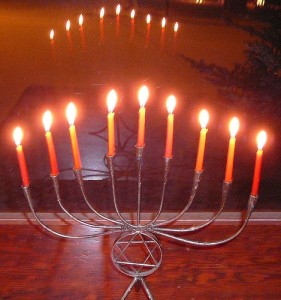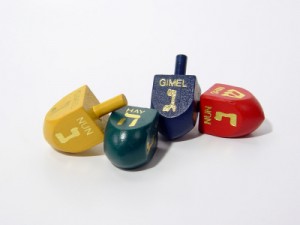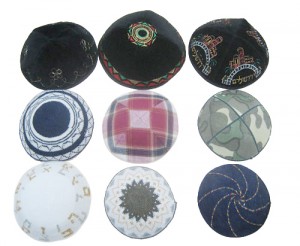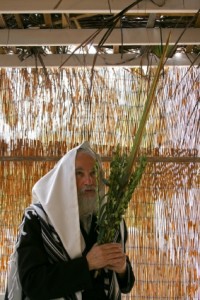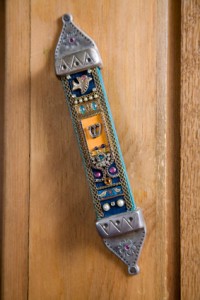Happy Hanukkah
Written by Zev on December 20, 2008 – 10:48 am -Hanukkah – the festival of lights is here! Light the menorah, play with the dreidel and feast on latkes and sufganiyots.
Gold Menorah wishes all Jewish readers a most joyous and happy Hanukkah!
Posted in Festivals, General | No Comments »
Why Menorahs Are Lit During Hanukkah
Written by Zev on November 25, 2008 – 12:00 pm -The Menorah is a candle holder (candelabra) that is lit during the 8-day festival of Hanukkah – “The Festival of Lights”. Hanukkah takes place on the 25th Day of the Hebrew Calendar month of Kislev, which falls around Christmas time.
Hanukkah marks a divine miracle that occurred in the 3rd century BC, following the defeat of the Seleucid Empire and the recapture of Jerusalem by the Jewish Maccabee army.
During the Seleucid occupation, the Jewish temple in Jerusalem was converted into a Pagan temple. When the temple was recaptured by the Maccabees, it was rededicated as a Jewish place or worship. The rededication process required a large quantity of consecrated olive oil for the oil lamps, but only 1 day’s worth was available. Through a miracle, the lamp burnt for 8 days by which time additional consecrated olive oil was prepared. That is why the festival lasts for 8 days.
The Menorah symbolises this miracle – it holds 8 candles, plus a separate candle known as the ‘Shamash’ that is used to light the others. On the first day of Hanukkah, a single candle is lit at sundown. On each successive day, an additional candle is lit. By the final day, all 8 candles are burning. The candles are ritually required to burn for a minimum of 30 minutes.
Many cities with significant Jewish communities honor this religious holiday by placing an electrically illuminated Menorah in a public square.
The following video demonstrates the correct procedure for lighting a Hanukkah Menorah:
Tags: Hanukkah, menorah
Posted in Festivals, Judaica | 1 Comment »
History of the Dreidel
Written by Zev on November 24, 2008 – 12:00 pm -A dreidel is a toy top used to play games of chance. It is a enjoyed especially by children as part of the festivities for the Jewish holiday of Hanukkah. The name comes from the Yiddish verb dreyden meaning ‘to turn’. In Hebrew, the toy is known as a ‘Sevivon’.
The dreidel has four sides, each marked with the hebrew letters Nun, Gimel, Hay and Shin. These are the first letters of the Hebrew sentence ‘Nes Gadol Haya Sham’ meaning ‘A Great Miracle Happened There’, referring to the story of Hanukkah.
The dreidel game is interesting in that it appears to be one of the few examples of religiously sanctioned gambling, which is normally frowned upon in Judeo-Christian traditions.
It can be played with real money, but this is often substituted with gold-wrapped chocolate coins [gelt], candy or plastic pieces.
The game requires four players. Each player spins the top in turn. Each Hebrew letter is associated with a specific outcome.
Nun: Nothing (lose a turn)
Gimel: Take everything in the prize pool
Hay: Take half of the prize pool
Shin: Contribute one piece to the prize pool
The game normally goes for a number of rounds to ensure that everyone has a chance to win a prize.
There is no consensus about the origin of the dreidel game. The least fascinating explanation is that it originated in the last several hundred years in Europe, having evolved from existing childrens games like Teetotum.
A deeper story states that it originated in ancient times, in places where Jews were forbidden from practising their religion. The Jewish people used the dreidel game as a decoy to hide the fact that they were secretly studying the Torah. When inspectors used to come to enforce the ban, Jewish students would quickly hide their books and pull out dreidels and pretend to have been playing games.
The dreidel has been popularised in recent years due to its appearance on TV shows like the Simpsons and South Park. The song “I have a Little Dreidel” has also become popular in the USA and is often sung together with Christmas carols.
Here is a detailed instructional video on Hanukkah Dreidel gameplay:
Tags: dreidel, Hanukkah
Posted in Festivals, Judaica | No Comments »
Why Do Jews Wear Kippahs?
Written by Zev on November 22, 2008 – 6:40 pm -A Kippah is the name for the skullcap that Jewish men wear on their heads. The word Kippah means ‘dome’ in Hebrew, due to its curved shape. Yiddish-speaking Jewish communities in Europe used the word Yarmulke instead of Kippah.
The religious purpose of wearing the Kippah is to signify that God is above everyone. It has become an accepted custom amongst observant Jews to wear the Kippah at all times. Less observant Jews may choose to only wear a Kippah whilst attending a religious service at a synagogue.
Kippahs are made from all kinds of cloth including cotton, wool, silk, satin and nylon. Decorations range from plain single colors to intricate multi-colored patterns.
Non-religious Jews and gentiles often wonder how the Kippah remains on the head, as it does not grip the head in the same way as a cap or top-hat. The answer is that it can be fastened in multiple ways – mostly, it is just a friction fit and Jews just learn not to jerk their heads suddenly. Other times, the hair is cut in a way to contour to the inside of the kippah. Some people attach Kippahs with hair clips or velcro pads, but many would consider this cheating.
Jewish women generally do not wear kippahs, but married women are required to cover their hair in some way, commonly with a hat, beanie or a wig.
Tags: kippah, yarmulke
Posted in Judaica | No Comments »
Sukkot and the Sukkah
Written by Zev on October 13, 2008 – 11:00 pm -The festival of Sukkot begins on the 15th day of the Hebrew month of Tishrei, which is 5 days after Yom Kippur and lasts for 7 days. It is immediately followed by the holidays Shemini Atzeret and Simchat Torah.
Sukkot is named after the plural form of Sukkah – the type of hut that Moses and the Israelites lived in as they wandered the desert for 40 years before they reached the Promised Land. These huts were made of branches and designed to be portable.
In English, Sukkah is sometimes translated as ‘booth’ or ‘tabernacle’, hence Sukkot is also known in English as the ‘Festival of Tabernacles’ or ‘Festival of Booths’.
During this holiday, Jews construct and reside in Sukkahs. Here families eat their meals, entertain guests, relax, and even sleep if weather and space permit it. It is important for to share meals with others. In fact this sharing is so important that the holiday is also know as Chag Ha’asif, Festival of the Ingathering.
The walls of the sukkah can be made from any material, including wood, canvas, plaster, or regular walls of glass or aluminium. A sukkah may be free-standing, or include one or two sides of a building or porch in its structure. The roof of a sukkah, however, must be of organic material that is detached from the ground. Palm fronds, branches, bamboo and wood are the most common roofing materials. The amount of shade inside the sukkah must exceed the amount of sunlight that can enter through the roof.
One of the best known Sukkot ceremonies is the waving of the ‘four species’ – three branches and one fruit, depicted in the above photo. These consist of the following:
Lulav – a ripe, green, closed frond from a date palm tree
Hadass – boughs with leaves from the myrtle tree
Aravah – branches with leaves from the willow tree
Etrog – the fruit of a citron tree
The ceremony is prescribed by the Torah, and contains symbolic allusions to a Jew’s service of God.
For more information including a video on how to build a Sukkah, click on more.
Tags: sukkah, sukkot
Posted in Festivals, Judaica | No Comments »
Happy Rosh Hashanah (Jewish New Year)
Written by Zev on September 29, 2008 – 6:00 pm -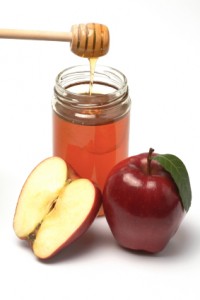
Gold Menorah wishes its readers a sweet and happy Rosh Hashanah!
Rosh Hashanah is the festival marking the start of the Jewish New Year, which occurs on the first day of the Month of Tishrei in the Hebrew calendar. This year is numbered 5769.
As the Hebrew Calendar is Lunar (based on the moon), its date changes from year to year. This year (2008), the festival starts at sunset, September the 29th and ends on sunset, October 1st.
Rosh Hashanah is a day of rest and Jewish people go to Synagogue to pray and hear the sounding of the Shofar. Jewish people greet each other joyously with the Hebrew phrase “Shana Tova!” – “A Good Year!”
The 10-day period between Rosh Hashanah and the next festival of Yom Kippur is known as the High Holidays. It is considered the best time for Jews to seek divine forgiveness and repent for wrongs commited in the previous year.
Tags: jewish new year, rosh hashanah
Posted in Festivals | No Comments »
The Shofar
Written by Zev on September 29, 2008 – 5:35 pm -The Shofar is a musical instrument, typically made from the horn of a ram, and used for Jewish religious purposes.
Today, most Jews hear its unmistakable wail while attending Synagogue during Rosh Hashanah (the Jewish New Year) and at the end of the Yom Kippur Fast (the Day of Atonement).
Here is a video demonstrating some common Shofar sounds:
We’ll take a look at the origin of this unique piece of Judaica and the various uses of the Shofar throughout Jewish history.
Tags: horn, shofar
Posted in Judaica | No Comments »
All About Mezuzahs
Written by Zev on September 23, 2008 – 12:27 am -A Mezuzah is a rectangular case that you often see mounted on the door frame of a Jewish household or Synagogue. Inside the case is a hand-scribed Hebrew parchment containing the words of the main Jewish prayer, the Shema.
The commandment to install Mezuzahs is derived from a sentence in the Shema that states – “Thou shalt write them [the words of the Shema] on the doorposts of your house and upon your gate”.
Mezuzah cases are made from all sorts of materials including base metals, silver, gold, plastic, wood and ceramics. They are usually mounted diagonally for the interesting reason that religious scholars are divided over whether the desired mounting should be horizontal or vertical.
Many Jewish families have a single Mezuzah on their front door. In more observant households, there may be one on the entrance to every room except bathrooms.
The following video demonstrates how to mount a Mezuzah, including the insertion of the parchment and the correct prayer to recite:
References:
- Mezuzah handbook by Dovid Zaklikowski
- “A Light Unto My Path”: A Mezuzah Anthology” by Alexander Poltorak
Tags: mezuzah
Posted in Judaica | No Comments »


